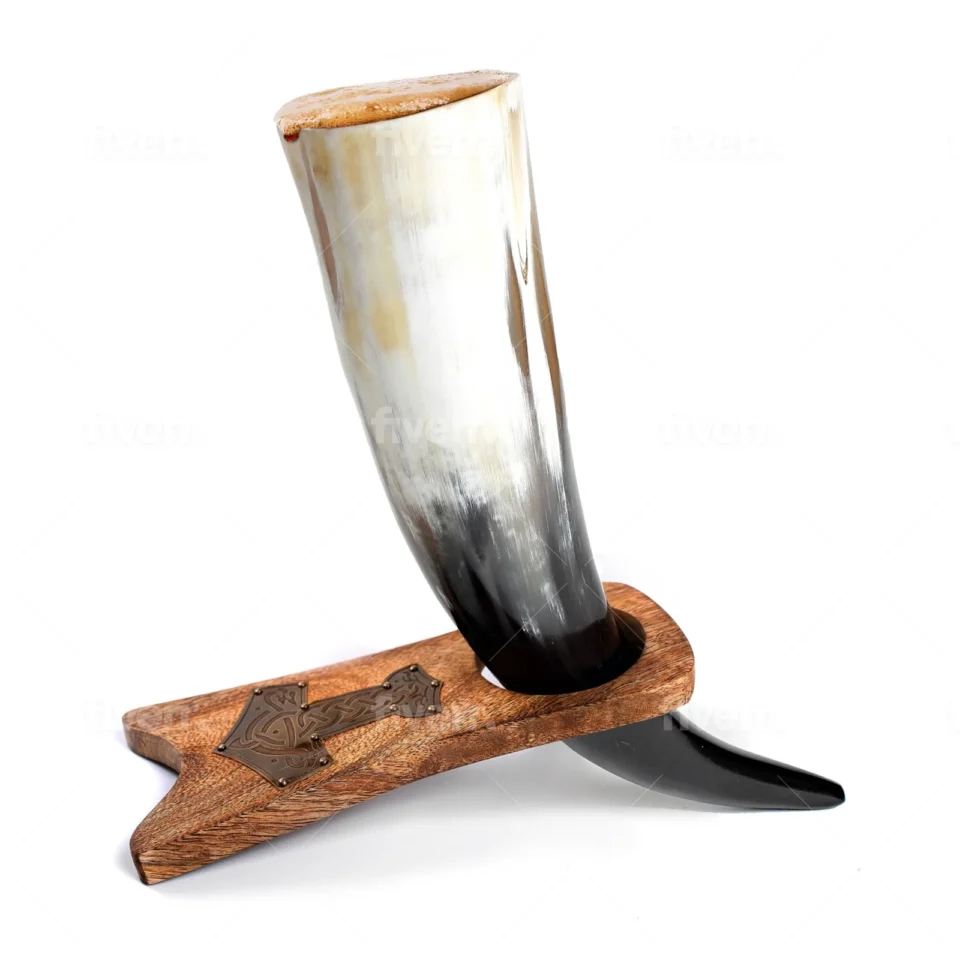Humans have been making use of animal horns for various purposes since prehistoric times. One of the oldest and most culturally significant uses of the horn is as a drinking vessel.
This article will guide you through the fascinating process of transforming a raw horn into a beautiful, functional drinking vessel.
Introduction to Horn Crafting
Before we delve into the process, it is important to have a broad understanding of horn crafting. Horn crafting is an ancient art form that requires a balance of skill, patience, and respect for the material.
Each piece of horn is unique in its color, texture, and shape, presenting unique challenges and opportunities for the craftsman.
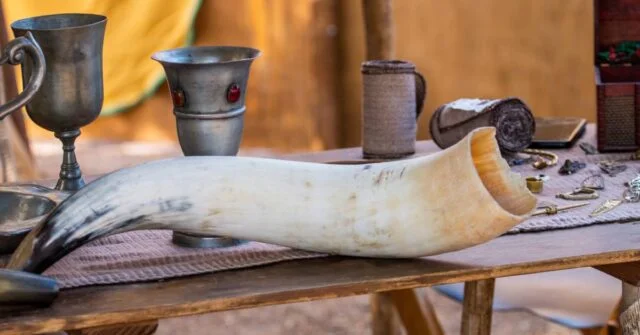
Understanding Raw Horn
Before we get into the practical aspects of working with raw horn, it’s important to understand what it is and where it comes from.
Raw horn is the unprocessed keratin-based substance that makes up the horn of various animals such as cows, goats, and buffaloes.
Types of Horns Suitable for Crafting
The type of horn used can significantly impact the final product. Different animals’ horns have different characteristics in terms of shape, size, and hardness.
For drinking vessels, cow and buffalo horns are the most commonly used due to their size and robustness.
Acquisition of Raw Horns
Raw horns are usually sourced from farms, butchers, or sustainable suppliers. It is important to ensure that the horns are sourced ethically, with animals not being harmed solely for their horns.

Properties of Raw Horns
Horns are composed primarily of keratin, the same protein found in our hair and nails. This makes them durable and resilient, but also able to be shaped and modified with the right tools and techniques.
Preparation of Raw Horn for Transformation
Once you have the raw horn, the next step is to prepare it for transformation. This involves cleaning, sizing, and marking the horn before the actual crafting process begins.
Inspection and Cleaning of the Raw Horn
Each raw horn needs to be thoroughly inspected for cracks or other defects that might affect its usability. After inspection, the horn is cleaned to remove any dirt, blood, or other residues.
This can be done using soap and warm water, followed by a thorough drying process.
Sizing and Marking the Horn
The horn is then marked for the desired size of the drinking vessel. The excess part of the horn, usually the tip, is then cut off. It is crucial to do this correctly, as an improperly sized horn can lead to a disproportionate vessel.
Hollowing Out the Horn
After the horn is cleaned and sized, the next step is to hollow it out. This process involves removing the inner core of the horn, making it hollow like a cup.
Tools and Techniques for Hollowing
The tools used for hollowing can range from simple hand tools to power tools depending on the size of the horn and the preference of the craftsman. The key is to remove the inner core without damaging the exterior of the horn.
Safety Precautions
As with any craft involving tools and raw materials, safety is paramount. Protective gear such as gloves and eye protection should be worn. Additionally, care should be taken to avoid sharp edges and hot tools.
Shaping the Horn
Once the horn is hollow, it is then heated and shaped into the desired form of the drinking vessel. This is where the craftsman’s skill really comes into play, as shaping the horn requires both strength and finesse.
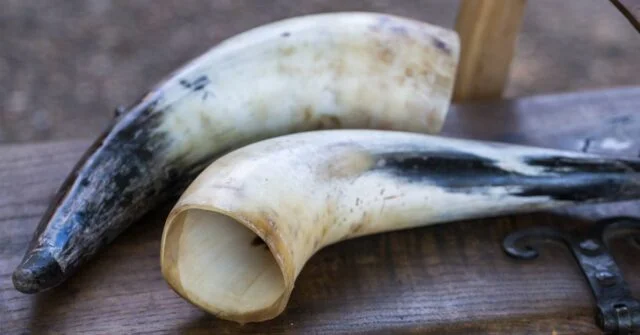
Techniques for Heating and Shaping
Horns are generally heated using a process called annealing, where the horn is slowly heated to a certain temperature to make it more malleable. It is then shaped using a variety of tools, often while still hot.
Shaping the Lip of the Drinking Vessel
The lip of the vessel is particularly important, as it will come in direct contact with the user’s mouth. It needs to be smooth and rounded for comfort. This can be achieved by careful shaping and sanding.
Smoothing and Polishing
After shaping, the horn vessel undergoes a process of smoothing and polishing.
This not only makes the vessel more aesthetically pleasing but also removes any sharp edges or rough surfaces that might be uncomfortable to the user.
Grinding the Exterior
The exterior of the horn is ground down using a grinding tool to achieve a smooth surface. This also allows the natural patterns and colors of the horn to shine through.
Smoothing the Interior
The interior is also smoothed using sanding tools. This makes the interior of the drinking vessel clean and pleasant to drink from.
Polishing for a Finished Look
The final step in this stage is polishing. Polishing gives the horn a shiny, finished look and brings out the natural beauty of the material. It also provides a level of protection for the horn.
Sealing the Horn
Once the horn is smooth and polished, it needs to be sealed. Sealing the horn makes it safe to drink from and helps to preserve the horn over time.
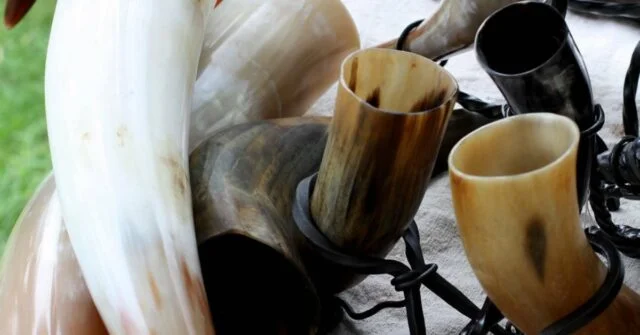
Why Sealing is Necessary
Sealing is necessary to protect the horn from the liquids it will hold. Without a proper seal, the horn can become damaged or discolored over time. Sealing also makes the vessel easier to clean.
Materials for Sealing: Pros and Cons
Various materials can be used for sealing, including natural substances like beeswax and synthetic sealants. Each has its own pros and cons in terms of durability, safety, and effect on the taste of the liquid.
Application Process
The sealing material is usually heated until it becomes liquid and then applied to the interior of the horn. It is then left to harden, forming a protective layer.
Decoration and Personalization
Now that the horn has been shaped, smoothed, and sealed, it’s time for decoration. The decoration stage is optional, but it can add a personal touch and make the drinking vessel truly unique.
Carving and Etching Techniques
Various carving and etching techniques can be used to decorate the horn. This can range from simple geometric designs to intricate scenes and patterns. The key is to carve carefully to avoid damaging the horn.
Applying Inlays and Other Embellishments
Other forms of decoration include the use of inlays, such as precious metals or gemstones, and other embellishments like leather wraps or metal bands.
These can add a touch of luxury and personalization to the horn-drinking vessel.
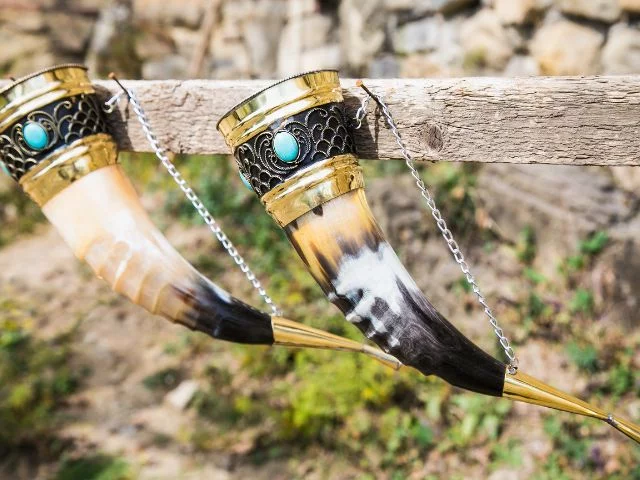
Preserving the Decorations
To ensure the longevity of the decorations, they are often coated with a protective layer. This not only helps to preserve the artwork but also enhances its appearance.
Final Touches and Preservation
After decoration, the horn drinking vessel undergoes final touches to prepare it for use and to ensure its preservation.
Applying Finishing Coats
A final finishing coat is applied to the horn to protect it and give it a glossy appearance. This can be a clear varnish or wax, depending on the desired finish.
Packing and Storing the Drinking Vessel
Once the final touches have been applied, the horn drinking vessel is carefully packed and stored to prevent damage. It is generally recommended to store the horn in a dry, cool place away from direct sunlight.
Caring for Your Horn Drinking Vessel
A well-crafted horn-drinking vessel can last for generations with proper care and maintenance. It is important to know how to clean and care for your horn to preserve its beauty and functionality.
Cleaning and Maintenance
After each use, the horn should be cleaned with mild soap and warm water. It should be dried immediately to prevent water damage. Regular polishing can also help to maintain the horn’s shine and protect its surface.
Restoration and Repair
Over time, the horn may show signs of wear and tear. In such cases, it may require restoration or repair. This can involve resealing the horn, repairing cracks, or re-polishing the surface.

Conclusion: The Value of Handcrafted Horn Drinking Vessels
Creating a drinking vessel from a raw horn is a journey of transformation that involves multiple stages, each requiring a different set of skills and techniques.
The result is not just a functional object, but a piece of art that carries with it a rich history and cultural significance.
Whether it’s for personal use or as a thoughtful gift, a handcrafted horn drinking vessel is a unique and valuable possession.






